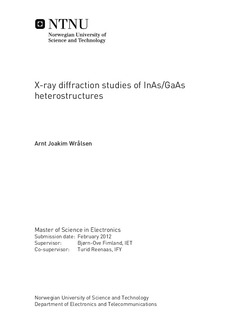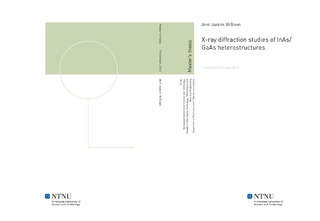| dc.contributor.advisor | Fimland, Bjørn-Ove | nb_NO |
| dc.contributor.author | Wrålsen, Arnt Joakim | nb_NO |
| dc.date.accessioned | 2014-12-19T13:47:28Z | |
| dc.date.accessioned | 2015-12-22T11:46:29Z | |
| dc.date.available | 2014-12-19T13:47:28Z | |
| dc.date.available | 2015-12-22T11:46:29Z | |
| dc.date.created | 2012-11-08 | nb_NO |
| dc.date.issued | 2012 | nb_NO |
| dc.identifier | 565854 | nb_NO |
| dc.identifier.uri | http://hdl.handle.net/11250/2370471 | |
| dc.description.abstract | Intermediate band solar cells (IBSC) is a proposed new type of solar cell device that has an intermediate energy band in the band gap. One possible implementation of IBSCs is by using arrays of nano-sized semiconductor particles known as quantum dots (QDs). InAs QDs can be grown on GaAs by using molecular beam epitaxy (MBE). As a part of this growth process, an InAs wetting layer (WL) is formed on which the InAs QDs grow. One possible method of determining the WL thickness is by using x-ray diffraction (XRD), which is a non-destructive analysis technique used to extract information about the structure and composition of crystalline thin films.An InAs/GaAs bilayer sample grown by MBE was investigated. This sample was grown without rotation, meaning the thicknesses of the deposited layers are expected to exhibit a gradient across the sample. Based on the geometry of the MBE machine, the variation in deposited thicknesses across the sample was estimated to be ±3.4% for InAs and ±4.2% for GaAs. XRD rocking curve measurements were performed around the 004 reflection in thirteen different locations on this sample. LEPTOS software was used to simulate XRD curves, and these simulations were fitted to the XRD measurements by varying the thicknesses of the simulated InAs and GaAs layers. It was found that the GaAs thicknesses across the sample varied as expected, while the variation in InAs thicknesses was much larger than expected. It was also found that the measured thicknesses of the InAs layer were significantly thinner than the nominal value. This is a strong indication that there are QDs on the sample, and that only the WL of the QDs contributes to the x-ray curve.LEPTOS was also used to simulate several cases of alloying of an InAs/GaAs bilayer. It was found that if the entire InAs layer is segregated into an InAs/GaAs alloy, this causes the diffraction peaks to weaken as the InAs/GaAs interfaces become less abrupt. It was also found that intermixing causes a significant change in the XRD curve because the amount of GaAs in the InAs/GaAs bilayer structure increases. | nb_NO |
| dc.language | eng | nb_NO |
| dc.publisher | Institutt for elektronikk og telekommunikasjon | nb_NO |
| dc.subject | ntnudaim:6080 | no_NO |
| dc.title | X-ray diffraction studies of InAs/GaAs heterostructures | nb_NO |
| dc.type | Master thesis | nb_NO |
| dc.source.pagenumber | 101 | nb_NO |
| dc.contributor.department | Norges teknisk-naturvitenskapelige universitet, Fakultet for informasjonsteknologi, matematikk og elektroteknikk, Institutt for elektronikk og telekommunikasjon | nb_NO |

